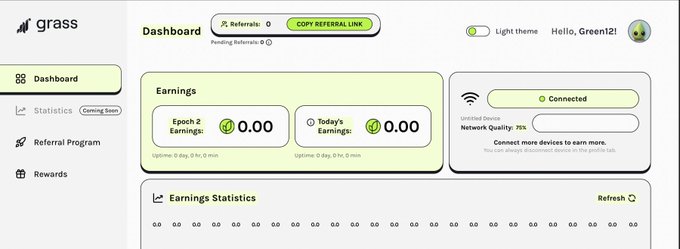
GRASS Airdrop 2024 - Eligibility, Process and Rewards

Are you looking to earn passive income while ensuring your privacy? Look no further than the GRASS Airdrop. This comprehensive guide will walk you through all the essential details you need to know about this exciting opportunity. From the concept behind GRASS to the step-by-step process of participating in the airdrop, we've got you covered. So, let's dive right in!
What is Grass?
Grass is a revolutionary blockchain-based web scraping protocol that enables sustainable and scalable data collection.
Unlike traditional networks that rely on exploitative intermediaries, Grass offers an equitable solution where both parties have an active stake in the network.
By selling your unused bandwidth through GRASS, you can earn passive income while keeping your privacy intact.
The GRASS Airdrop
The GRASS Airdrop allows participants to earn GRASS tokens for free. These tokens hold significant potential value and can be converted into other cryptocurrencies or used within the GRASS ecosystem.
The airdrop is expected to attract many participants with a total value of over $4.5 million.
Airdrop Details
- Platform: GRASS's own chain
- Deadline: 8th March 2024
- Investment: GRASS has raised $4.5 million from investors like Polychain Capital and Tribe Capital.
$4.5M In Funding - 3 Weeks Left To Farm!
- Cost: $0
- Time: 20 min
- Potential gain: $10,000+
Please note that while the GRASS Airdrop has been confirmed for March 2024, there is no guarantee that it will happen. However, the high possibility of an airdrop makes it an exciting opportunity to explore.
Also Read - Top Upcoming Confirmed Crypto Airdrops
How to Participate in the GRASS Airdrop?
Participating in the GRASS Airdrop is a straightforward process. Follow the step-by-step guide below to ensure you are eligible for the airdrop:
Step 1: Register
To register for the GRASS Airdrop, visit the GRASS registration page. Enter your email and username, and create a password. Confirm the password, agree to the terms, complete the captcha, and click Register.
Step 2: Download the GRASS Extension
Next, download the GRASS extension by visiting the Chrome Web Store. This extension is essential for earning GRASS points and participating in the airdrop.
Step 3: Connect to GRASS
Once you have downloaded the extension, login to the GRASS extension using the registration details you provided earlier. This will connect your account to the GRASS network, enabling you to start earning GRASS points.
Click Refresh if you still can't see your connected device in the top right corner.
◈ Once you've successfully connected, you'll see the Connected button and your Uptime.

Step 4: Referral Program
Maximize your earnings by taking advantage of the GRASS referral program. Copy your unique referral link and share it with your friends. You will receive 20% of your referred friends' points, 10% of the secondary referee's points, and 5% of the tertiary referees' points.
Step 5: Farm Tokens
To earn more tokens, stay active on the GRASS network for an extended period. You can also connect additional networks by clicking on "Add Network" within the GRASS extension, boosting your token earnings.

Potential Value and Benefits of GRASS Tokens
While the exact value of GRASS tokens is yet to be determined, they hold significant potential for future growth. As GRASS continues to develop its ecosystem, the tokens may gain value and become tradable on various cryptocurrency exchanges.
Furthermore, GRASS has plans to launch a governance token in the future, allowing users to participate in network decision-making processes.
Conclusion
The GRASS Airdrop presents a fantastic opportunity to earn passive income by selling your unused bandwidth through a sustainable and privacy-focused protocol. With a total funding of $4.5 million and the possibility of an airdrop, the potential value of GRASS tokens is substantial.
By following the step-by-step guide, you can ensure your eligibility for the airdrop and maximize your earnings. Take advantage of this exciting opportunity to be part of the GRASS network and start earning today!
Disclaimer
The information provided on this website does not constitute investment advice, financial advice, trading advice, or any other advice, and you should not treat any of the website's content as such.
Token Metrics does not recommend buying, selling, or holding any cryptocurrency. Conduct your due diligence and consult your financial advisor before making investment decisions.

.svg)

Create Your Free Token Metrics Account

.png)




%201.svg)
%201.svg)


%201.svg)









.svg)




.png)